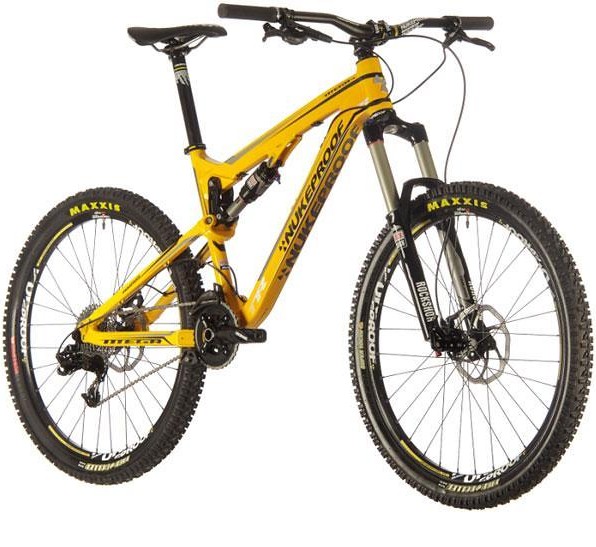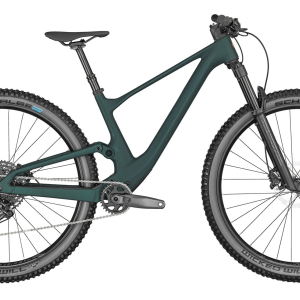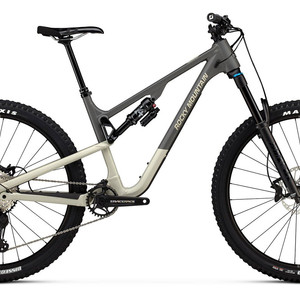2013 Nukeproof Mega TR
(discontinued)
| Where To Buy | |||
|---|---|---|---|
Free shipping on orders over $50 (continental U.S. only).
International shipping available. Some exclusions apply. |
|||
Free shipping on orders over $50 (continental U.S. only).
International shipping available. Some exclusions apply. |
|||
Review by Johan Hjord // Photos by Johan Hjord and Tal Rozow
Nukeproof launched the original Mega to much acclaim back in early 2011, and it quickly became one of the defining models of this young brand. With a slack headtube angle and relatively short travel, the original Mega was at the heart of the modern trailbike movement – fun, capable bikes that can pretty much go anywhere and do anything. For 2013, Nukeproof has increased its offerings in this category by creating an “AM” and a “TR” version of the Mega. The AM version gets a boost to 160mm travel (up from the 150mm of the original Mega), while the TR sees travel reduced to 130mm in a more lightweight package. Curious to see how capable the TR would remain, we laid our hands on one of the very first samples a couple of months ago – here is how we got along.

Nukeproof Mega TR Highlights
- Hydroformed T6 6061 aluminum tubeset
- 130mm travel
- True 44mm headtube
- Removable cable guides for dropper post, also internal Stealth cable routing
- ISCG 05 tabs
- Head angle: 67-degrees
- Seat angle: 73.5-degrees
- Rear axle: 135mm/142mm x 12mm
- Chainstay length: 430.2mm
- BB height: +0mm
- Direct mount front derailleur ready
- MSRP $4,349.99

Nukeproof’s intentions are obvious with this bike: 67-degree head angle, wide bars, short stem, single chain ring with a chainguide…while it may “only” sport 130mm of travel, clearlythis bike was built for good times. The yellow paint job may not be to everybody’s liking, but we think it looks awesome in the flesh.There is a more subtle grey version available as well, should you feel the need for stealth. The yellow works well with the Nukeproof finishing kit – this bike certainly turns a few heads. The hydroforming on the main triangle tubes is quite pronounced, and gives the Mega TR a very purposeful look. Although the Mega TR was designed with weight in mind it is still built tough in all the right places, with an oversized seat stay bridge and a solid main pivot helping with stiffness.
Looking over the build kit, the bike seemed ready to roll out of the box, and since we were too, we wasted no time…
On The Trail
We rode the Mega TR for two months solid, and we managed to take it pretty much everywhere - rolling woodland, desert epics, or steep and rough DH trails, the bike saw all kinds of conditions. Since our goal was to really test the bike in order to find out just how capable the 130mm trail bike can be, we pointed it at a few extracurricular features as well.

We were pleased to find that Nukeproof is on the ball when it comes to the basics. 760mm bars on a 50mm stem meant we could just get on with riding it, not having to waste time and money swapping out ridiculously narrow bars and long stems that for some reason still plague many a trail bike. Nukeproof even spec'd 170mm cranks on the Mega TR, clearly favoring performance on the downward side of the mountain.
The Mega TR comes with 2.35-inch Maxxis Highrollers in the single-ply version (super tacky 42a upfront and hard-wearing 60a in the rear) – proven all-round performers that provide a confidence-inspiring ride. Obviously, single-ply was chosen to keep the weight under control, and while we appreciate their grip and snappy handling, we would probably end up with the dual-ply version eventually. We did have a couple of snakebite incidents following some less-than-legendary line choices.
Moving out, everything about this bike feels lively. With the suspension pressure set at the lower limits of the recommended range both in the fork and the shock, the bike is still very snappy and wastes little energy. The geometry works well enough for long climbs and epic days in the saddle, with a centered and neutral position. I rode a size Medium, and at 1.84-meters (about 6-feet), it was a little on the tight side with a 590mm effective top tube, but still perfectly manageable for long days out.
Of course it’s no XC racer, but it’s very far from a slouch. The suspension is well-controlled during pedaling with almost no discernible pedal-induced bobbing. We never felt the need to play around with the different “Pedal” and “Locked” compression settings, at least not for climbing/pedaling purposes. Laying down the power out of turns or sprinting rewards you with instant acceleration, and the back end remains active during technical climbing as well.

Efficient pedaler as it may be, it is when the trail points downwards that the Mega TR really starts to shine. Lightweight bikes with snappy handling can often feel skittish – at least, that is how things used to be. However, with a slack 67-degree head angle and a relatively long wheelbase, the Mega TR surprised us more than once. We found ourselves charging into sections on familiar trails thinking “I really should have a bigger bike for this one” only to come out grinning on the other side. That's a good thing, given how easy it is to pick up speed with this bike. It does not feel flimsy at all, despite the low weight and relatively lightweight components.
On flowy singletrack, the Mega TR is all about entertainment. Flicking through trees, popping off bumps or railing turns, the bike keeps you in balance and ready to charge at every occasion, aided by a relatively low bottom bracket and sub 17-inch chain stays.

Getting airborne is easy, the Mega TR is a very neutral jumper - totally predictable off the lip and very confidence-inspiring in the air. If you are used to hardtails, you’ll be right in your element jumping the Mega TR.

As we previously pointed out, we rode the Mega TR mainly with the suspension pressure at the lower end of the recommended range for our weight, which yielded between 30-35% of sag. We found this to be the most rewarding set-up for the majority of trails – still stiff enough to pedal without needing to play with compression settings, yet soft enough to deal with 95% of the trail features you would expect to be riding with this kind of bike. The leverage ratio curve of the Mega TR is quite linear, which works well with the progressive nature of the air shock itself. The RockShox Monarch RT3 on this bike features a large volume air can to provide a more linear feel, but it still ramps up nicely towards the end of the stroke. When pushed, it will bottom out, but it does so without much fuss.

So who is this bike for then? This is a much harder question to answer than you might think, because pretty much anybody should find a lot to like about the Mega TR. If your focus is trail riding, you’d hardly go wrong with this bike – it’ll take you there and back, and you’ll have as much fun as you can legally have on the way. The Mega TR is eminently capable of pedaling, and hard to beat for grins as soon as the trail points downwards. If you err on the XC side, you can find more efficient bikes out there, but for everybody else, this is about as much fun as you can have on a trail bike. Of course, the trail bike segment (up to 140mm typically) is today very much turning into 29er territory, and with the rise of the 650B wheel for the so-called “Enduro” category, the Mega TR won’t provide an answer to those looking to explore the new wheelsize options. However, if you’re a bit of a traditionalist or still ready to NOT choose a bike based on wheelsize, the Mega TR should make your shortlist.
For the more gravity-oriented among us, we see two main categories of riders: those looking to complement a longer travel bike, and those looking for a heavy hitting do-it-all. For the latter, the obvious choice is the Mega AM – more travel and burlier components would set your mind at ease on the rougher trails and bigger features. The TR can deal with it, but you can’t help but feel a bit sorry for it sometimes when charging hard. That leaves the riders looking for a second bike for those longer days in the saddle or bigger climbs. Here, we find it hard to look past the Mega TR. With a bigger bike available for the burlier trails, these riders will fully appreciate the playfulness and efficiency of the Mega TR. They also might find themselves reaching for it a lot more often than they’d have thought – we did.
Build Kit
We received a stock Mega TR as it ships from Nukeproof’s main global distributor, Hotlines, but note that there may be slight differences in spec depending on where you order from. The build kit is at the appropriate level for the price and the intended usage of the bike, although we do have a few observations to offer.

The frame is “Reverb ready,” meaning it features a port on the seat tube for internal cable routing to a dropper post. Sadly, it does not ship with one in the stock configuration. We really think it should. Dropper posts are an essential fun-factor on a trail bike, and really bring out the best in a bike like the Mega TR, so plan on adding one. In light of the lack of a dropper post, we were surprised to find a non-QR seatpost clamp on ours, as the one thing you’ll be doing all day with a bike like this is move your saddle up and down. We replaced it with a generic QR version immediately. The seatpost supplied with our bike was on the shorter side (
Avid’s Elixir 5 brakes are predictable and offer good modulation and a positive feeling at the lever. However, the bike ships with dual 170mm rotors, which leaves the brakes lacking power on steep descents. We upgraded to a 200mm rotor up front to remedy the problem and provide stopping power to match the bike's downhill prowess - this did the trick although we observed some brake fade issues on longer descents.
The bike arrived with a 36-tooth chainring. Since it's a 1X setup, riders without massive legs may want to size down a tooth or two. A 34-tooth chainring would add a little comfort to the climbs without penalizing the high end.
SRAM's X7 shifter and a Type 2 SRAM X9 rear derailleur combo was flawless during the test, although the X7 shifter doesn’t feel quite as crisp as an X9 does. The clutch derailleur works a treat, helping with chain retention and quieting down chainslap. The bike ships without a chainstay protector, and you'll want to add one to prevent the paint from chipping.We don’t know much about the supplied “Prime Aero” chainguide other than it being featured on several Nukeproof bikes that ship with a guide. It did its job, although it’s a bit finicky to adjust, and not the quietest guide when pedaling.
The RockShox Revelation RL Solo Air fork offers 150mm travel in an air-sprung 32mm chassis, with adjustable rebound and compression. Ours came with a 15mm Maxle which functioned well during the test, although you need to keep an eye on the tension of the set screw to ensure it stays snug – it can rattle itself loose on occasion. This fork is a pure pleasure to hammer through the rough stuff on, and certainly stiff enough for most of what you can throw at it. It rides fairly high in its travel even at lower pressure, and is really a very positive and confidence-inspiring fork. We did have a dust wiper pop out during the test, but we popped it back in and that was the end of that incident. Out back, a RockShox Monarch RT3 with a high volume air can provides a pretty firm ride, even at lower pressures.
Finally, Nukeproof's own components finish things off nicely. The bar and stem combo (760mm/50mm) is spot on for the intended usage of this bike, and the bars are comfortable as are the grips. The saddle, while being on the firm side, is perfectly fine for all-day riding, and the Nukeproof Generator TR wheels (made for Nukeproof by Sun Ringlé) have taken a beating and kept coming back for more. The headset did not require much in terms of adjustment or care during the test.
Things That Could Be Improved
We have already pointed out a few shortcomings of the part spec above. While we think a couple of changes there would make sense, the bike still rips straight out of the box, the build quality is good, the welds are tidy, and the bike always felt solid. The pivots do their job, although we might question the use of 4mm Hex bolts throughout – they look ready for a little head stripping action should the going get a bit ham-fisted, so check your torque specs and wrench with care. We also found that the graphics on the handlebars chip quite easily. Overall, the Mega TR is just a tiny bit rough around the edges here and there, but none of that takes away from an overall impression of quality and good finish.
Long Term Durability
We had a few issues with creaks, although this may be due to the fact that our test bike was one of the early samples. We had to replace the bushings in the rear pivots after Nukeproof informed us that the factory assembled the early frames with the wrong bushing kit. It’s possible that riding it with the loose-fitting bushings early on contributed to causing the other pivots to creak a bit. In any case, after greasing and tightening all the pivots, the problem seemed to mostly go away.
The Truvativ Descendant cranks have developed a small “clunk,” and worked themselves loose a couple of times. In our experience, the Truvativ crank/spindle interface is prone to this, so this is something you should be aware of. Make sure you have an 8mm hex key in your riding pack and keep an eye on it. Other than that, after being ridden hard for two months, the bike feels as tight as it did on day one and is ready for more of the same. We certainly do not have any serious longevity concerns to report.

What’s The Bottom Line?
How good can a 130mm travel 26-inch wheeled bike be? That was the question we wanted an answer to when we slung a leg over the Nukeproof Mega TR. Two months and many miles later, the answer is clear: pretty much as good as it gets. The Mega TR is a snappy pedaler and a good companion for long days out. On the trail, it builds up speed very easily, and it never fails to put a huge grin on your face when things get twisty. Point it downhill, through the rough or in the air, and you’ll get to the bottom laughing and ready to climb back up for more. Sure the short travel will hold you back a little through the roughest parts, but you’ll soon find it might be more fun popping over stuff than you ever imagined. If you are looking for a trail bike and don’t want to let wheelsize dictate your choice, then put the Mega TR on your short list.
For more details, visit www.nukeproof.com.
Bonus Gallery: 24 photos of the 2013 Nukeproof Mega TR
About The Reviewer
Johan Hjord loves bikes, which strangely doesn’t make him any better at riding them. After many years spent practicing falling off cliffs with his snowboard, he took up mountain biking in 2005. Ever since, he’s mostly been riding bikes with too much suspension travel to cover up his many flaws as a rider. His 200-pound body weight coupled with unique skill for poor line choice and clumsy landings make him an expert on durability - if parts survive Johan, they’re pretty much okay for anybody. Johan rides flat pedals with a riding style that he describes as "none" (when in actuality he rips!). Having found most trail features to be not to his liking, Johan uses much of his spare time building his own. Johan’s other accomplishments include surviving this far and helping keep the Vital Media Machine’s stoke dial firmly on 11.
Specifications
| Where To Buy | |||
|---|---|---|---|
Free shipping on orders over $50 (continental U.S. only).
International shipping available. Some exclusions apply. |
|||
Free shipping on orders over $50 (continental U.S. only).
International shipping available. Some exclusions apply. |
|||

























0 comments
Post a reply to: Tested: Nukeproof Mega TR – Nukeproof by Name, Nukeproof by Natu